 |
 |
 |
| |
High HCV Rate in Both Young and
Older Drug Injectors--HIV Ups HCV Risk
|
| |
| |
AIDS 2020: 23rd International AIDS Conference Virtual, July 6-10, 2020
HIV was 6% among young & 9% in older PWID. HCV prevalence was much higher than HIV prevalence and nearly the same in young injectors (43%) and older injectors (45%). author said: This is concerning because young must be engaging in high risk behaviors that put them at risk for HCV & HIV.
The CDC investigators conclude that current HCV infection is linked to HIV infection and high-risk injection behaviors in young drug injectors. Higher use of syringe service programs by young injectors with HCV indicates that these programs are reaching a high-risk population, as they are intended to do. The researchers stressed the need for tailored prevention program to prevent HCV infection and HIV outbreaks in drug injectors.
Mark Mascolini
Young people who inject drugs are just as likely to have HCV infection as their older counterparts, according to a 3735-person 10-city study by the Centers for Disease Control and Prevention (CDC) [1]. Young injectors with HIV are 30% more likely than HIV-negative young injectors to have current HCV infection.
CDC officials noted that recent HIV outbreaks in the United States followed spikes in HCV infection among young people who inject drugs. These surges in new HIV infections happened in places with prevention and substance use programs in place.
To get a better understanding of what was happening, CDC investigators analyzed data from the National HIV Behavioral Surveillance (NHBS) system, which used respondent-driven sampling to survey drug injectors in 10 US cities in 2018 to gauge HIV and HCV prevalence and related risk behaviors. Field workers interviewed drug injectors at least 18 years old and tested them for HIV and HCV. Researchers used bivariable and multivariable Poisson regression analyses to compare young and older drug injectors and to identify factors associated with current HCV in young injectors.
Among all 3735 drug injectors included in the NHBS in 2018, 12% were young (18 to 29 years old), 27% were in their 30s, 24% were in their 40s, and 37% were 50 or older. 2
HIV prevalence proved slightly but not significantly lower in young drug injectors (18-29 years old) than in injectors 30 or older: 6% versus 9%. HCV prevalence was much higher than HIV prevalence and nearly the same in young injectors (43%) and older injectors (45%).
Regression analysis involving 3735 injectors in 2018 adjusted for region and respondent-driven sampling (RDS) network size determined that older (30+ years) injectors were more likely than young injectors to have injected for 2 or more years (about 90% vs 78%, adjusted prevalence ratio [aPR] 0.5, 95% confidence interval [CI] 0.4 to 0.6). But three sociobehavioral factors proved more frequent among younger than older injectors:
-- Receptively sharing syringes or equipment (about 62% vs 50%): aPR 1.4, 95% CI 1.3 to 1.6
-- Incarcerated in last 12 months (about 50% vs 30%): aPR 1.4, 95% CI 1.1 to 1.7
-- Currently homeless (about 65% vs 50%): aPR 1.3, 95% CI 1.2 to 1.4
In this regression analysis, younger injectors did not differ significantly from older injectors in HIV prevalence (aPR 0.9, 95% CI 0.7 to 1.1) or HCV prevalence (aPR 0.9, 95% CI 0.8 to 1.1).
To determine factors associated with current HCV in 460 young drug injectors, another multivariate model adjusted for region, RDS network size, race, current incarceration, injection duration, injection frequency, receptive sharing of syringes or equipment in the last 12 months, overdose in the last 12 months, daily heroin injection, daily cocaine injection, always using sterile syringes in the last 12 months, and syringe service program use in the last 12 months. This analysis identified five variables significantly associated being HCV-positive versus negative:
-- White or other vs black (about 60% HCV+ vs 37% HCV-): aPR 2.0, 95% CI 1.0 to 4.0
-- Injecting 2 or more years (about 75% HCV+ vs 42% HCV-): aPR 1.5, 95% CI 1.1 to 2.3
-- Receptively sharing syringes/equipment (about 73% HCV+ vs 57% HCV-): aPR 1.1, 95% CI 1.0 to 1.2
-- Using syringe service program in last 12 months (about 71% HCV+ vs 42% HCV-): aPR 1.3, 95% CI 1.2 to 1.4
-- Diagnosed with HIV (about 10% HCV+ vs 4% HCV-): aPR 1.3, 95% CI 1.1 to 1.6
The CDC investigators conclude that current HCV infection is linked to HIV infection and high-risk injection behaviors in young drug injectors. Higher use of syringe service programs by young injectors with HCV indicates that these programs are reaching a high-risk population, as they are intended to do. The researchers stressed the need for tailored prevention program to prevent HCV infection and HIV outbreaks in drug injectors.
Reference
1. Burnett J, Broz D, Chapin-Bardales J, et al. High levels of receptive sharing and HIV among young PWID with HCV from 10 U.S. cities--implications for HIV elimination efforts. AIDS 2020: 23rd International AIDS Conference Virtual. July 6-10, 2020. Abstract PEC0421.
https://events.ugovirtual.com/event/AIDS2020/en-us#!/Auditorium
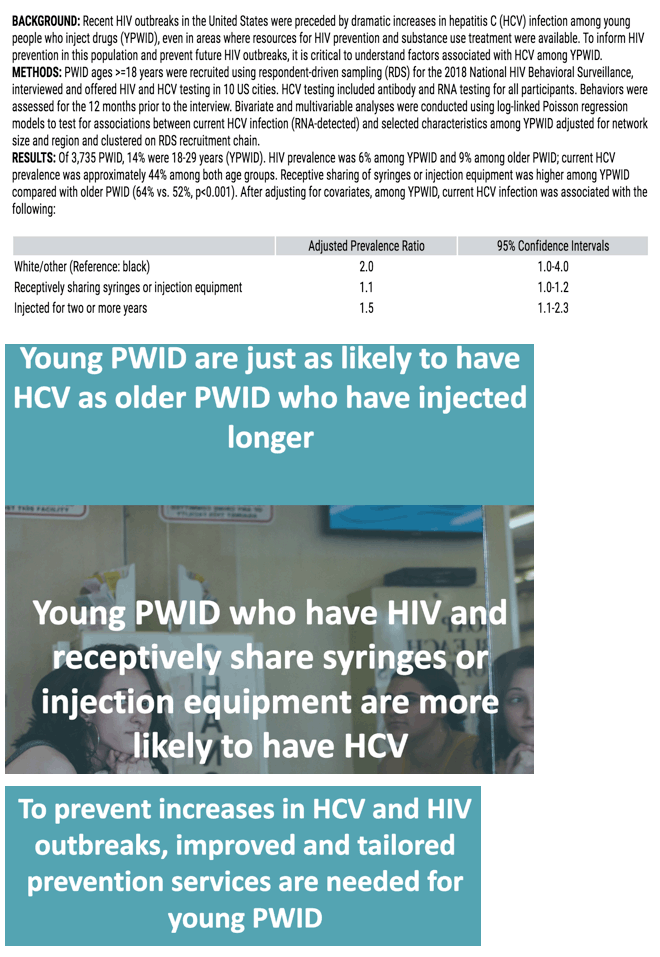
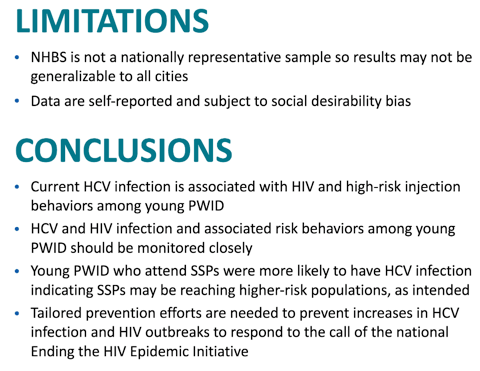

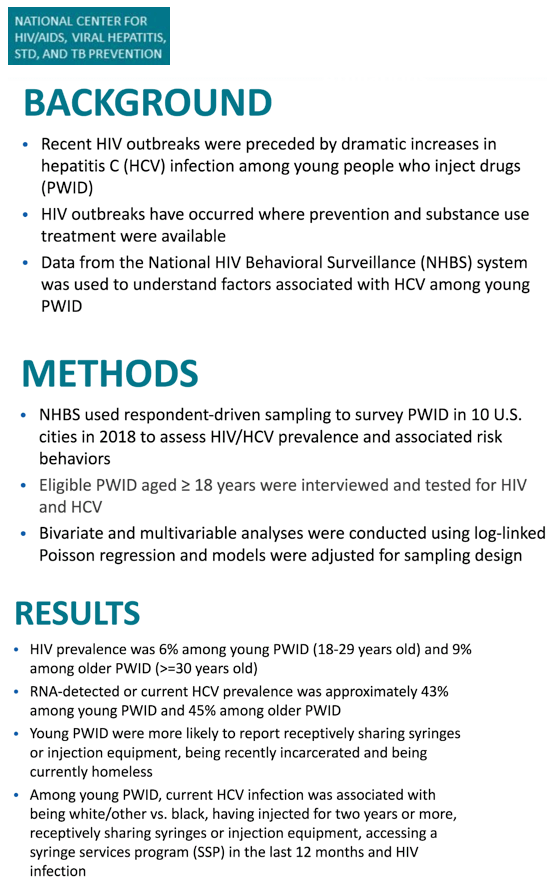
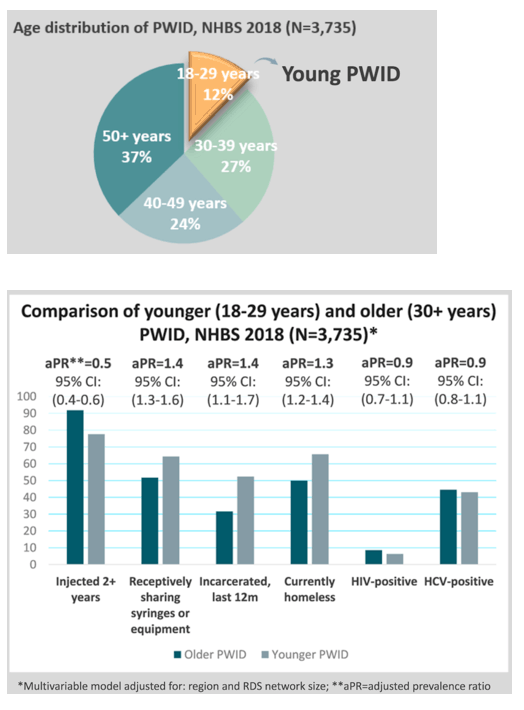
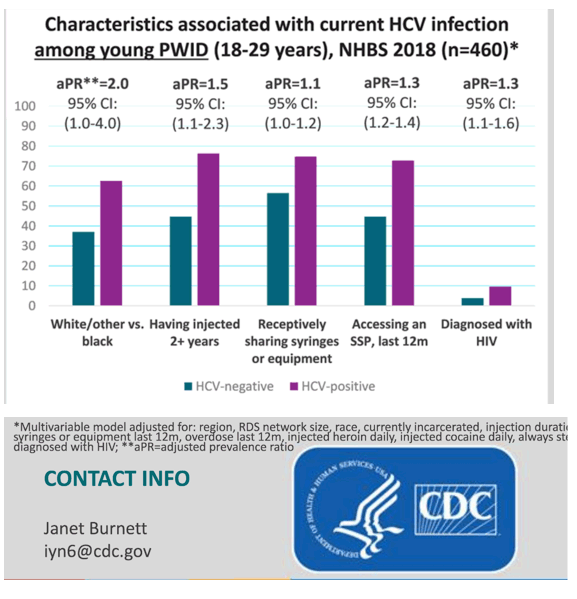
|
| |
|
 |
 |
|
|